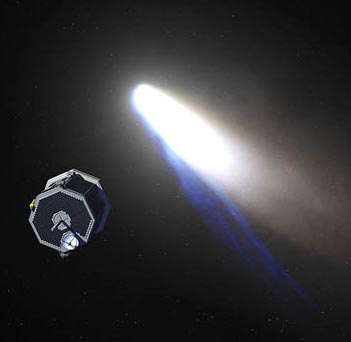
NASA UPDATE ON AUGUST 26, 2002:
"On Aug. 15, CONTOUR's STAR 30 solid-propellant rocket motor
> was programmed to ignite at 4:49 a.m. EDT, giving CONTOUR
> enough boost to escape Earth's orbit. At that time, CONTOUR
> was about 140 miles above the Indian Ocean and out of radio
> contact with controllers. The CONTOUR mission operations team
> at APL expected to regain contact at approximately 5:35 a.m.
> EDT to confirm the burn, but NASA's Deep Space Network (DSN)
> antennas did not acquire a signal.
>
> Since then, there has been no contact with CONTOUR. Commands
> pre-programmed into the spacecraft's flight computer system,
> designed to instruct the spacecraft to try various alternate
> methods of contacting Earth when contact is lost, also have
> not worked to date.
>
> Images from a Spacewatch ground-based telescope at Kitt Peak,
> Ariz., show three objects at the location where CONTOUR was
> predicted to be, images which may indicate the spacecraft has
> broken apart. Mission controllers at APL will continue
> listening for signals from the spacecraft periodically until
> early December, when CONTOUR will come into a more favorable
> angle for receiving a signal from Earth."
August 16, 2002 Laurel, Maryland - Late this afternoon at Johns Hopkins University's Applied Physics Laboratory (JHUAPL), Dr. Robert Farquhar, Mission Director for the Comet Nucleus Tour (CONTOUR), teleconferenced with reporters about the status of the missing CONTOUR spacecraft. CONTOUR's STAR 30 solid-propellant rocket motor was programmed to ignite at 4:49 a.m. EDT yesterday, August 15, to launch the probe out of Earth orbit onto a trajectory to study two or three comets over the next few years. At that burn time, CONTOUR was over the Indian Ocean at 140 miles (225 kilometers), too low for NASA's Deep Space Network stations to track the spacecraft during the burn. All systems seemed to be OK going into the burn, but 45 minutes later when the JHUAPL mission operations team tried to regain contact with the probe, no signal was received.
Click here to subscribe and get instant access to read this report.
Click here to check your existing subscription status.
Existing members, login below:
© 1998 - 2025 by Linda Moulton Howe.
All Rights Reserved.

